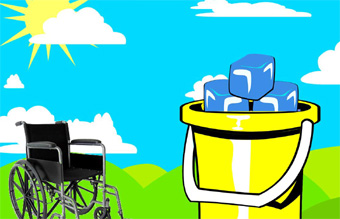
Photocomposition Thursday Review staff
ALS & The Ice-Bucket Challenge
| published February 6, 2016 |
By Earl Perkins, Thursday Review features editor
Researchers at Johns Hopkins University may have discovered a major breakthrough in ALS research, partially crediting their success to a massive influx of cash primarily realized through a public awareness campaign in the past year, according to The Washington Post.
Those of us who know people with ALS, or those whose loved ones have already passed on from the disease, were thrilled when videos and photos of people pouring buckets of cold water on their heads went viral on Facebook and other social media. ALS, commonly-known as Lou Gehrig's disease, became famous again when the Ice Bucket Challenge took over social media.
Some claimed that people weren't making a difference, and had forgotten the disease. Social media slacktivism, they called it. So those ice-bucket stunts became ubiquitous and almost constant, with do-gooders acting like they were making a difference in a way never before seen. Detractors of the campaign saw it as unseemly, or as people merely seeking attention for themselves through the now familiar process of videotaping bizarre behavior and often risky pranks. But the world is changing, and unfortunately private industry just isn't going to fund research unless it can financially justify the expenditure (thus, some would argue, the research sector and pharmaceutical industries’ almost single-minded focus on treating symptoms of diseases, as opposed to finding cures).
Amyotrophic lateral sclerosis—the full name for ALS—wasn't striking down enough people in the prime of their life. Private medical research firms knew other diseases were more widespread and showed better promise for larger profits. But within the last two years, the publicity has helped raise more than $220 million in donations to help seek a cure, and that sum has helped turn the tide.
"Without it, we wouldn't have been able to come out with the studies as quickly as we did," said Philip Wong, a professor at Johns Hopkins who led the research team. "The funding from the Ice Bucket is just a component of the whole—in part, it facilitated our effort."
Wong and his team have been studying ALS for about a decade, and fellow researcher Jonathan Ling says the additional millions allowed researchers the financial stability to pursue "high risk, high reward" experiments, according to his Ask Me Anything thread on Reddit.
"The money came at a critical time when we needed it," Wong said.
There are currently 15,000 Americans living with ALS, which has no known cure, so patients are dying at a rate from two to five years following diagnosis. But about a decade ago, researchers discovered numerous ALS patients had protein TDP-43 forming outside the nuclei of their brain cells, and wondered whether that was a cause or effect of the disease. In a study published last week in the journal Science, Johns Hopkins scientists detail how TDP-43—which is supposed to decode DNA—breaks down and becomes "sticky" in mice cells. It is unable to properly read DNA and the cell dies within days.
However, when researchers inserted a special protein designed to mimic TDP-43 into neurons, the cells came back to life. The news sparked interest the treatment might slow or halt the disease.
Researchers plan to conduct more experiments to see if a mimicking protein may be used as a therapeutic model to treat mice as a whole organism, instead of just a cell, according to Wong. If the testing goes favorably, the project would progress to clinical trials on humans.
And with the research community receiving this recent windfall, the trial would already be funded. Although there has been massive attention concerning ALS on social media, it's a relatively rare disease. Around 7,000 Americans are killed by the disease annually, according to the Centers for Disease Control and Prevention in Atlanta—about two in every 100,000 deaths.
And despite saying it wouldn't be "presidential," President George W. Bush was doused for the ALS Ice Bucket Challenge, getting caught up in the cause with hundreds of celebrities and politicians. The campaign helped the ALS Association collect $115 million last year, which is a 4,100 percent increase in fundraising over the $2.8 million raised the previous year.
Critics argue such large donations to a rare disease like ALS leads to "funding cannibalism," meaning the funds are being diverted from research on other diseases which might impact more people. Wong strongly disagrees with that opinion, noting donations for research are not necessarily one big pie.
"In other diseases, you can take similar strategies to bring about awareness and have people come in to support it," he said. "This helps to drive other foundations to promote their cause. It's doing more good than bad."
Understanding these proteins could have a much broader impact beyond the ALS community, possibly helping battle Alzheimer's disease, muscular dystrophy and inclusion body myositis.
"The lesson that we learned can be applied to other human diseases," Wong said. "There's a much greater number of people affected by this."
Related Thursday Review articles:
Open Wide; Thursday Review staff; Thursday Review; August 6, 2015.
Christmas Gifts for Enlisted Personnel & Families; Thursday Review staff; Thursday Review; December 23, 2015.
